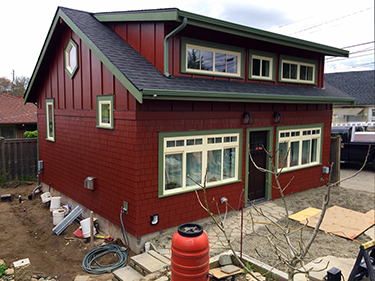|
Subscribe / Renew |
|
|
Contact Us |
|
| ► Subscribe to our Free Weekly Newsletter | |
| home | Welcome, sign in or click here to subscribe. | login |
Architecture & Engineering
| |
May 18, 2018
Durkan to fast-track backyard cottages
Seattle will fast-track preapproved designs for detached accessory dwelling units (DADUs) and hire architects to develop several standard architectural plans for backyard cottages that could be built and permitted more quickly and at a lower cost.
Mayor Jenny A. Durkan issued the directive yesterday to get more housing built in Seattle.
“Seattle faces an affordability and housing crisis, and we are taking urgent action to increase the supply of rental housing options as quickly as possible,” Durkan said in a press release. “Too many people are being pushed out of this city or can't find a place to live. We need to use every tool in our toolbox to boost the supply of housing.”
The city said standardized, preapproved plans will save builders and residents time and money by streamlining design, reducing costs and accelerating permits.
Hiring an architect to do an original design for a backyard cottage typically costs $10,000 to $30,000, the city said in the release, and construction can cost $300,000.
The announcement coincides with the release of a draft environmental impact statement, at https://tinyurl.com/ybe8v7gc, that evaluates the proposal by Councilmember Mike O'Brien to remove regulatory barriers to ADU construction.
There will be an open house and public hearing at 5:30 p.m. May 31 at City Hall, 600 Fourth Ave.
Seattle ordinances allow two types of ADUs: apartments inside a single-family home and detached backyard cottages. Seattle homeowners have created 1,591 in-law apartments and 579 backyard cottages since they were first allowed in 1994 and 2010, respectively. Homeowners received permits to build 263 ADUs last year.
Under current ADU regulations, the homeowner must live on the property, only one ADU is allowed per lot, and the property must include two parking spaces, one for the main home, and one for the ADU.
The draft EIS studies three alternatives for land use code changes related to ADUs:
• No action
• Allowing one in-law apartment and one backyard cottage on the same lot; no parking required for ADUs; and allowing the homeowner to live elsewhere.
• Allowing two ADUs per lot (either two in-law apartments or one apartment and one cottage); an additional parking space would be required if two ADUs are built.
The last two alternatives would reduce the minimum lot size to build an ADU from 4,000 square feet to 3,200 square feet, and allow for slightly larger cottages and apartments.
The last alternative also explores the option of including a size restriction on new single-family homes by implementing a floor area ratio limit. Today, the size of single-family homes is limited only by yard requirements, height limits and lot coverage limits.
The no action alternative anticipates homeowners would build 1,890 ADUs by 2027. Alternatives 2 and 3 would both result in an increase in ADU construction in the next decade: 3,330 and 3,100 total new ADUs, respectively.
The city said potential policy changes analyzed through the environmental review would increase rental housing options in areas where housing is unaffordable to most households.
Since 2016, Seattle's single-family home prices have grown faster than any U.S. city, with the cost of the average home now $820,000.
Under Seattle's zoning, approximately 7,400 acres allow for multifamily, commercial and mixed-use buildings, while 21,000 acres are zoned exclusively for single-family homes, the city said. There are roughly 135,000 lots in the single-family zones.
Citywide, construction in 2017 added 8,730 net new homes, mostly apartments and townhomes. Last year, 88 percent of all new homes were built in urban villages. The number of detached single-family homes in Seattle remained essentially unchanged.
In December 2016, the Seattle Hearing Examiner ruled that a full EIS on O'Brien's proposal was required before changes could be adopted.
The final EIS and a preferred alternative will be developed based on community comments already received and input on the three alternatives in the DEIS.
Council staff expects to complete the final EIS in September before draft legislation is developed for the City Council.



